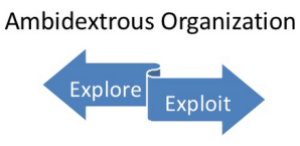 So how do businesses organise their structures to be able to simultaneously manage the needs to exploit and explore innovation?
So how do businesses organise their structures to be able to simultaneously manage the needs to exploit and explore innovation?
In this post I wanted to explain my thinking through on this ability to be ‘ambidextrous’, knowing the difference of when to exploit and when to explore as essential to leveraging innovation, in all its forms and watching out for some of the traps in not managing this well.
Managing this, in all honesty, though, is hard to get the balance right but highly valuable if you do achieve it, it can transform the business. Many of our organisations struggle to manage both successfully as they tend to focus more on separation mostly in organisational structures alone as their attempt to become ambidextrous. It is far more than ‘just’ this. Get the balance right across the organisation’s design and in its leadership management, it becomes a very powerful mechanism for accelerating performances by delivering significantly new innovation and equally sustaining and leveraging the core business you have today.
Recently I contributed a blog post over on the Hype Innovation Blog ” Balancing Exploitation & Exploration for Changing Performance” that opens up the subject but then extensively dives into three examples of Apple, GE and Google that are working in highly ambidextrous ways, pursuing exploiting and exploring in their own unique ways.
Continue reading “So how do you manage exploiting and exploring for Innovation?”

